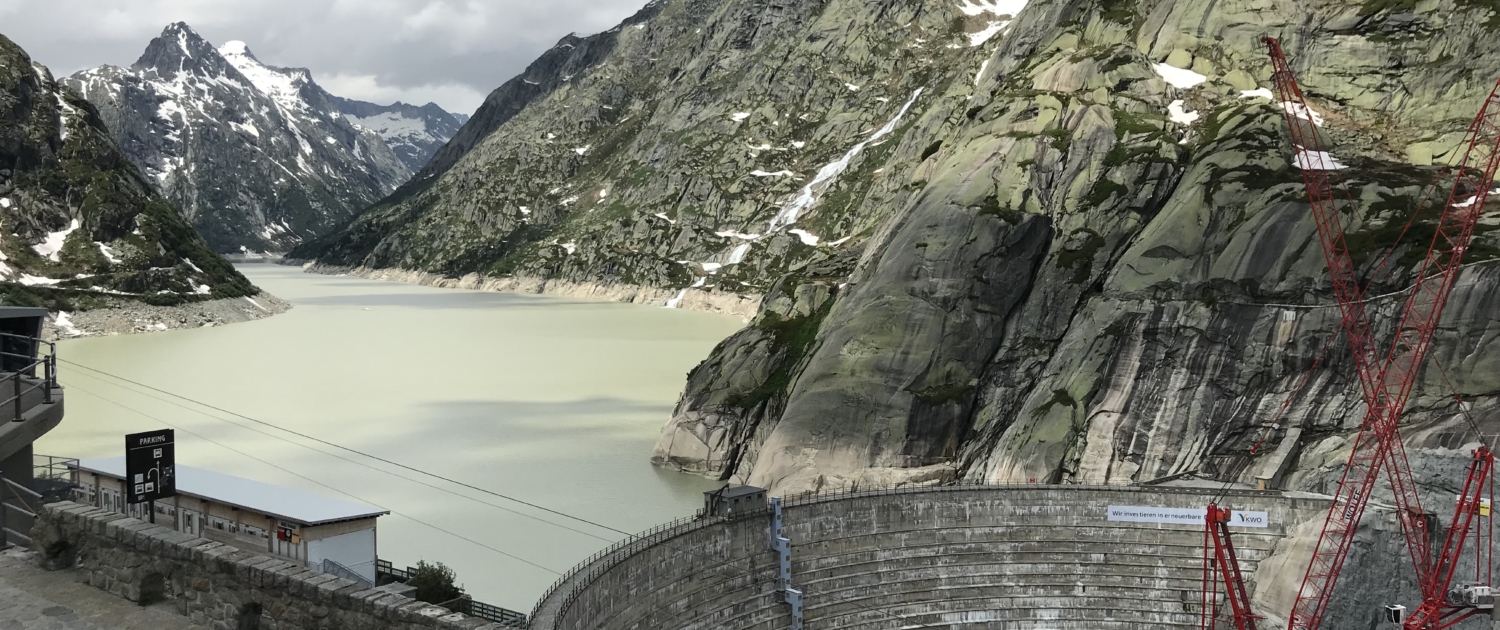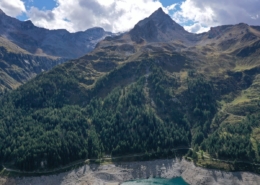Role of the SFOE in the construction of the Spitallamm Wall on the Grimse River
Hydropower plays an important role in the Energy Strategy 2050. By replacing the Spitallamm dam, Kraftwerke Oberhasli AG (KWO) aims to ensure that the water from Lake Grimsel can be used for electricity production in the long term. Construction began in June 2019, and the foundation stone was laid in June 2021. Ralph Kienle, technical specialist in the Supervision of Dams section at the Swiss Federal Office of Energy, explains the role of the SFOE in this project.
Energeiaplus: At 1900 metres above sea level, Kraftwerke Oberhasli is building a new dam in front of the old one by 2025. The old wall will then be flooded. The SFOE is responsible for overseeing the safety of dams in Switzerland. What is the challenge with this construction project from the supervisory authority's point of view?
Ralph Kienle: We are not aware that a new dam has ever been planned directly on the air side of a fully dammed dam.
The big challenge for us was, above all, at the beginning: the KWO submitted a project with the intention of building the new wall and, at the same time, continuing to operate the existing dam as normal. In other words, they would fill the reservoir and empty it to produce electricity as before.
What considerations did the SFOE have in this regard?
During the project appraisal phase of the building permit procedure, it was our task as the supervisory authority to assess whether all conceivable damage and failure scenarios had been taken into account. With regard to the excavation for the foundation of the new wall (June 2019 to November 2020), i.e. for the blasting and rock removal work that was carried out in the foundation area of the old wall, we requested additional stability verifications from the KWO before the start of construction, assuming extreme scenarios.
For example, we asked ourselves: How will the existing wall behave if the stable rock on which this wall stands is removed for the foundation of the new wall? All stability verifications were successfully carried out.
Incidentally, we are being supported in our work on the Spitallamm project by an engineering expert and a geology expert in order to be able to master the technically demanding work, which is also time-consuming.
What did the excavation then reveal?
During the rock excavation, the project geologist continuously updated the geological forecasts. Individual stability verifications had to be checked and recalculated on the basis of the actual recordings. The results showed that the project can continue as planned.
Is the dammed "old" wall a problem for the future operation of the Grimsel dam?
We discussed intensively whether the dammed "old" wall could pose a risk to the entire dam. Here, too, we broke new ground, raised and rejected many questions, but in the end were unable to identify any significant hazards with conviction.
We thought of various phenomena. A selection of them: Could the old wall concrete expand faster ("swell") if the existing wall is surrounded by water on both sides? What effects would this have on the rock flanks ("pushing" them away)? The existing wall is to be flooded.
Ventilation of wall cavities was also an issue (more on this below). The KWO also calculated what would happen if the water in the 'small lake' between the old and the new wall froze, and whether and how this would increase the pressure on the wall (keyword ice pressure).
The current Spitallamm wall is about 90 years old and in need of repair. Would it have been possible to use the water from Lake Grimsel without a new construction?
The signs of ageing and the deterioration of the condition or the existing damage have steadily increased, recently even rather accelerating. In an expert report from 2011, the KWO was able to show that there is no immediate danger to third parties, not even in the event of an earthquake. However, the further development was difficult to estimate and had to be based on many models and assumptions. At some point, however, the Spitallamm dam, and with it Lake Grimsel in the upper part, would have become unusable, which would already have led to a considerable loss of production.
In order to avoid an unclear, uncertain and unplannable situation, and in the knowledge that the project planning and realisation of a renovation or a new construction of the dam would take several years, the SFOE decided in 2015 to order the KWO to immediately take up the planning work for the renovation of the Spitallamm dam and to submit a project ready for approval by 2017. The aim is, of course, that this will then be implemented in terms of construction.
How is the SFOE monitoring the project and the construction work on the Grimsel?
In April 2016, a good year before the approval project was submitted, there was the first meeting between KWO and the SFOE. This concerned the handling of safety-related issues relating to the construction project. At the beginning of June 2017, we then received the project documents from the responsible construction approval authority of the Canton of Berne with the order to carry out the safety review.
Our result was: The new dam meets the safety requirements (construction method, concrete quality, monitoring, flood safety, lake emptying options), provided that certain conditions are met.
These are conditions that affect every phase of the project: Before construction begins, during construction, or in connection with commissioning. Regular meetings are held between KWO, its planners and geologist, as well as the SFOE and the experts that the SFOE has called in, to discuss the status of the processing of the conditions and to monitor the development of the project.
Since 2016, there have been 19 meetings within this framework. Depending on the time of year, the meetings are held on site and include a tour of the construction site. Of course, a view of the beautiful landscape and the impressive construction site facilities is not to be missed. I also like to take note of the good progress of the construction work.
How is the dam being operated and the stored water being used during the 6-year construction period?
Completely unrestricted, with the exception of a three-month drawdown of Lake Grimsel at the beginning of 2025 for construction reasons. When the new dam is completed, the old Spitallamm dam will be flooded, as mentioned above. This will require compensating and connecting tunnels in the existing wall so that the air in the wall's cavities (control passages, connecting shafts, rooms for installations) can escape completely.
Otherwise, air bubbles remain, which can develop destructive forces and cause undesirable damage to the wall. Ideally, these galleries should only be created when the lake is lowered. Connections for flow paths from one side of the old wall to the other are also needed, otherwise the new wall would remain dry.
How is it at all possible that the operation can take place without restrictions?
The reasons are as follows:
- The KWO has provided all the necessary evidence (and this has been verified by the SFOE and its experts) that the existing wall continues to meet all stability requirements. In order to prepare the necessary foundation zone for the new wall, rock had to be removed using blasting techniques in the very vicinity of the wall and directly at the base of the wall (see photo). The blasting work itself was also subject to certain restrictions.
- A dam is not a rigid construction, it is always somewhat in motion. Even during normal operation, the behaviour of all dams is monitored. In this case, the existing wall has been subject to increased monitoring for the past two years in accordance with a monitoring plan that was drawn up jointly by KWO and the SFOE and finally approved by the SFOE:
Additional, partly automated measuring instruments have been installed for this purpose. These record the values around the clock. In the case of non-automated instruments, manual measurements are carried out by the KWO dam attendants e.g. twice a week throughout the year. The KWO continuously evaluates and interprets the results. - Every two weeks, the KWO graphically processes the data and sends a report to the SFOE. We then also assess whether everything is "in the green". If this is not the case, the causes must be determined, the possible consequences assessed and the necessary corrective measures decided. So far, the latter has never been the case.
Facts about the Grimsel dam:
Lake Grimsel today holds 94 million m3 of water (energy content: 263 gigawatt hours).
The existing Spitallamm dam is 113 metres high. It was built between 1926 and 1932. The Seeuferegg wall is also part of the plant.
The new Spitallamm wall cost 125 million Swiss francs.
Lake Grimsel is the KWO's best-known, largest and most important reservoir. It is actually too small for its catchment area - in summer a lot of water has to be used for power generation (because otherwise the lake overflows), which could be better used in winter.
The KWO would therefore like to raise the dam by 23 metres. This would increase the storage volume of the reservoir by 75 million cubic metres to a new 170 million cubic metres. Storage of an additional 240 GWh of energy would be possible. This would be enough to supply 60,000 to 100,000 households with electricity.
Interview: Brigitte Mader, Communications, Swiss Federal Office of Energy
 BFE - Ralph Kienle
BFE - Ralph Kienle
 3 Vote(s), Durchschnitt: 4,67
3 Vote(s), Durchschnitt: 4,67 ©ShutterstockWie ist der Stand der Cyber-Security in der Schweizer Stromversorgung und wie sieht die Strategie für ihre…
©ShutterstockWie ist der Stand der Cyber-Security in der Schweizer Stromversorgung und wie sieht die Strategie für ihre…  ©ETHZ Institut für GeotechnikWarum Erdmassen nicht so leicht abrutschen
©ETHZ Institut für GeotechnikWarum Erdmassen nicht so leicht abrutschen  Energiestrategie 2050: Schlussspurt
Energiestrategie 2050: Schlussspurt  Salon PublicSalon Public: Special Edition Energiezukunft
Salon PublicSalon Public: Special Edition Energiezukunft 
 take and drive
take and drive BFE
BFE
Dein Kommentar
An Diskussion beteiligen?Hinterlassen Sie uns Ihren Kommentar!